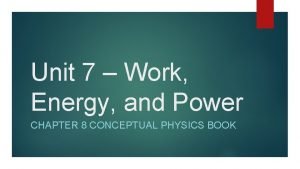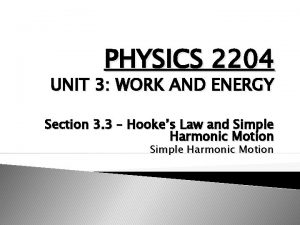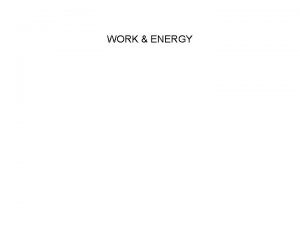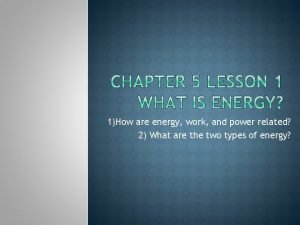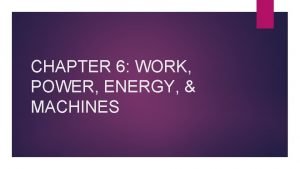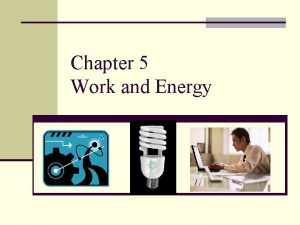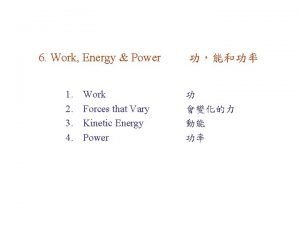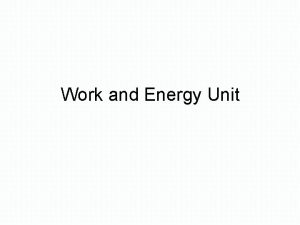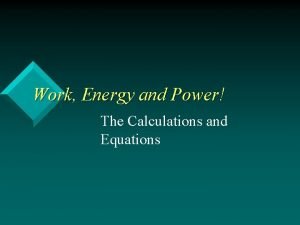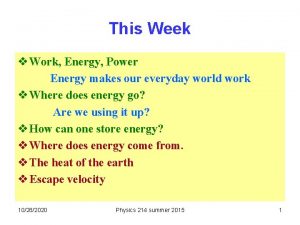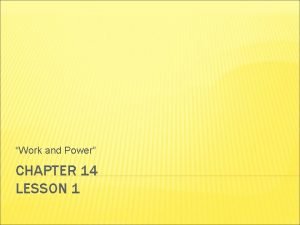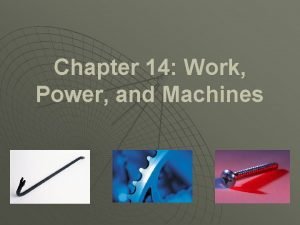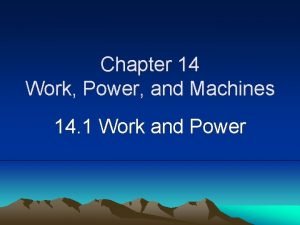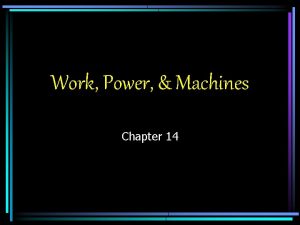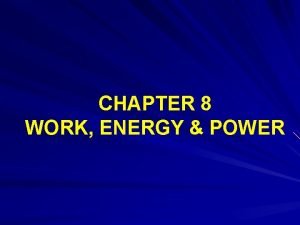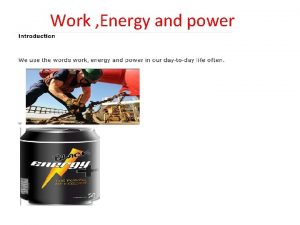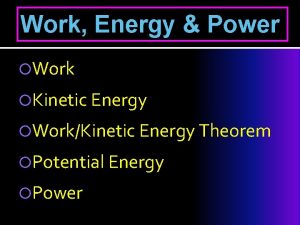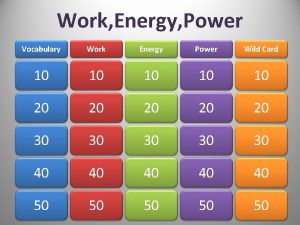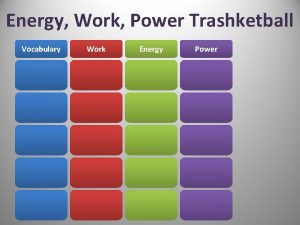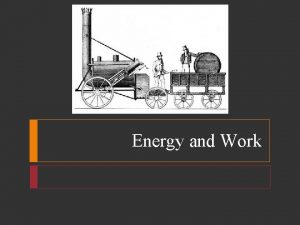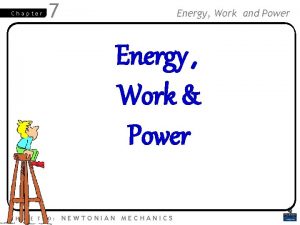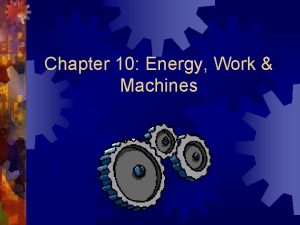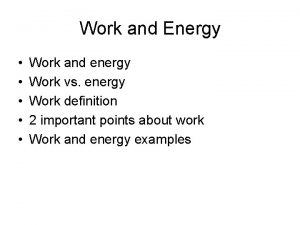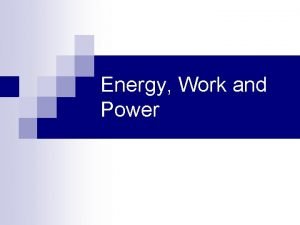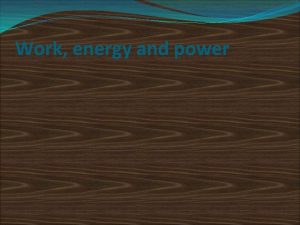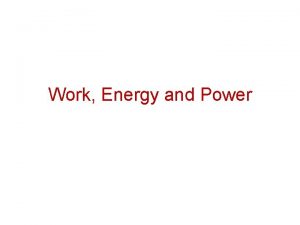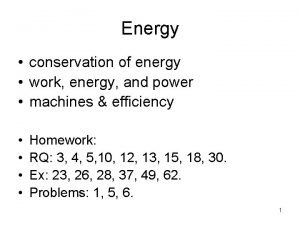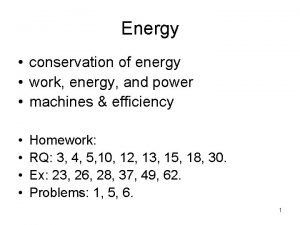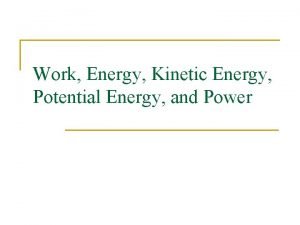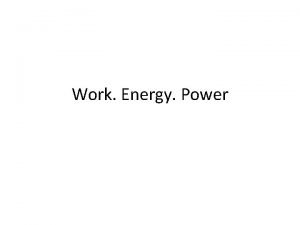Unit 7 Work Energy and Power CHAPTER 8























- Slides: 23

Unit 7 – Work, Energy, and Power CHAPTER 8 CONCEPTUAL PHYSICS BOOK

Part 2 ENERGY

Energy (E) – the ability to do work. Types of energy: Mechanical Electrical Nuclear Heat Chemical Sound – kinetic + potential

Kinetic Energy

Kinetic Energy Example

Work-Energy Theorem

Work-Energy Theorem Example 1

Work-Energy Theorem Example 2

Power Example #3

Gravitational Potential Energy

Potential Energy Example

12 Conservative vs. Nonconservative Forces Conservative force – total Work on a closed path is zero. (ex: gravity) Gravity- down Motion- up -W +W Gravity- down Motion- down Nonconservative force – total Work on a closed path is NOT zero. (ex: friction) Friction - right Motion- left -W -W Energy Friction – left Motion - right

Conservation of Energy

Conservation of Mechanical Energy

Conceptual Example 1: Pendulum - Kinetic and Potential Energy In the absence of air resistance and friction… the pendulum would swing forever example of conservation of mechanical energy Potential → Kinetic → Potential and so on… In reality, air resistance and friction cause mechanical energy loss, so the pendulum will eventually stop.

Conceptual Example 2: Roller Coaster - Kinetic and Potential Energy

With Non-Conservative Forces…

Conceptual Example 3: Downhill Skiing - Kinetic and Potential Energy This animation neglects friction and air resistance until the bottom of the hill. Friction is provided by the unpacked snow. Mechanical energy loss (nonconservative force) Negative work

Problem Solving Insights Determine if non-conservative forces are included. If yes: MEf = ME 0 + Wnc If no: (We won’t be solving this type) MEf = ME 0 Eliminate pieces that are zero before solving Key words: starts from rest (KE 0 = 0), ends on the ground (PEf = 0), etc.

Example 1 A 2. 00 kg rock is released from rest from a height of 20. 0 m. Ignore air resistance & determine the kinetic, potential, & mechanical energy at each of the following heights: 20. 0 m, 12. 0 m, 0 m (Round g to 10 m/s 2 for ease)

Example 1 - Answers Height 20. 0 m KE PE ME 0 J Start Here 2*10*20 = 400 J 12. 0 m 400 -240 = 160 J 2*10*12 = 240 J 400 J 0 m 400 -0 = 400 J 2*10*0 = 0 J 400 J Then Use This

22 Example 2 Find the potential energy, kinetic energy, mechanical energy, velocity, and height of the skater at the various locations below. Energy max

23 Example 2 - Answers
 Jenis usaha apa
Jenis usaha apa Chapter 4 work and energy section 1 work and machines
Chapter 4 work and energy section 1 work and machines Physics 2204 unit 3: work, power, energy
Physics 2204 unit 3: work, power, energy Work, power and energy activities
Work, power and energy activities Power definition physics
Power definition physics How are energy work and power related
How are energy work and power related Work power energy and machines
Work power energy and machines Definition of work power and energy
Definition of work power and energy Work power and energy
Work power and energy Physics 03-02 potential energy and conservative forces
Physics 03-02 potential energy and conservative forces Chemical potential energy images
Chemical potential energy images Ac power formula
Ac power formula Unit of work and energy
Unit of work and energy Energy energy transfer and general energy analysis
Energy energy transfer and general energy analysis Energy energy transfer and general energy analysis
Energy energy transfer and general energy analysis 0kei0
0kei0 Regents physics work power energy
Regents physics work power energy Work energy power equations
Work energy power equations Work and energy
Work and energy Chapter 14 section 1 work and power
Chapter 14 section 1 work and power Chapter 14 work power and machines
Chapter 14 work power and machines Work power and machines
Work power and machines Chapter 14 work power and machines
Chapter 14 work power and machines Chapter 8 work and power answers
Chapter 8 work and power answers
